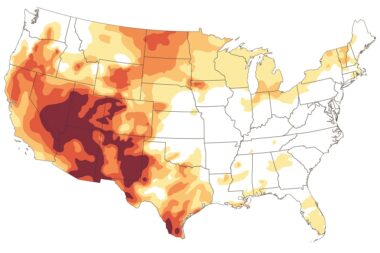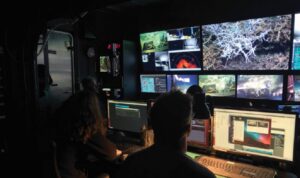Those of us in the Earth observations field, have a special affinity for this question as we have had to ask it many times on the long journey of launching satellites, collecting data, analyzing Earth’s changes, and predicting future trends. Are we there yet, at that moment when disparate data systems across the federal agencies are integrated easily? Are we there yet, when a potential user of Earth observations can easily discover and apply data and information that they need? Are we there yet, when services for climate, land cover change, oceans, and ecosystems are elevated to the operational level of weather services?
The introduction of the Biden administration’s American Jobs Plan with its estimated $2 trillion infrastructure investment, raises hope that finally arriving at some of these visionary destinations could be in reach. With the plan intended to create jobs and rebuild infrastructure, the climate crises and competition with China emerge as two key drivers. That is where the vital link to U.S. Earth observations and environmental information exists. It is imperative to recognize that without federally supported, long-term Earth observations, science and applications, climate insights would not be possible and our global leadership and positioning in respect to China minimized. Therefore, the work of NOAA, NASA, the U.S. Geological Survey (USGS), National Science Foundation (NSF) and others must be recognized as critical to the success of the American Jobs Plan.
Three important intersections for the Earth and environmental information sector as it relates to re-imagining and rebuilding a new economy include ensuring that a “whole of government” approach translates to “whole of Earth,” engaging and supporting business, and realizing a national Earth predictive capability to win the future.
A “WHOLE OF EARTH” APPROACH
In the case of re-imagining or rebuilding a new post-pandemic economy, it is essential that the “whole of government” response translates into a “whole of Earth” approach. No one Federal agency holds the knowledge products needed to clearly identify the best path forward. NASA, NOAA, USGS, NSF, and other agencies, along with the research community they support, all make unique and valuable contributions to our understanding of the changing planet. Assets such as satellites, drones, ships, uncrewed marine vehicles, and data collected by citizen scientists are as diverse as the agencies that comprise the federal Earth observations and information sector.
Through efforts such as the U.S. Global Change Research Program (USGCRP) which produces the quadrennial National Climate Assessment, and the U.S. Group on Earth Observations (USGEO), much progress has been made in interagency coordination to provide the nation with comprehensive assessments and products as well as a unified strategy for international cooperation.
However, just as the American Jobs Plan addresses building new roads and bridges, the question arises as to whether these coordination entities — the USGCRP, USGEO, and others — that were established in 1989 and 2005, respectively, are positioned to meet the challenge accelerating impacts of climate, biodiversity loss, or emerging pandemic risk. After all, NOAA reported that their global carbon measurement recorded a new high April 3, topping 421 parts per million (PPM). Measurements tell us one thing, but translating measurements to solutions and action for preparing and protecting the nation will require much more.
The National Academies of Sciences, Engineering, and Medicine address this point in a new report that calls on the USGCRP to “shift its focus to providing insights that help society prepare for and avoid the worst potential consequences of climate change, while protecting the most vulnerable.”
And as if anyone still needed any convincing, February’s events in Texas show the critical importance of observations and environmental information in dealing with climate risk. In his op-ed, Texas cold snap was not ‘unprecedented,’ and it was inexcusable to be unprepared, former NOAA chief operating officer David Titley states, “This event was the latest instance in which millions of dollars in adaptation would have prevented billions of dollars of damage, saved lives and greatly reduced the suffering of Texans.”
So, how should the United States “build back better” beginning with the federal Earth and environmental information in support of informing this vital infrastructure initiative?
Experts such as Justin Kenney, senior adviser to the United Nations Foundation, believes ocean research — which historically has been underfunded in the past — must be elevated with an expanded role for NOAA. “The ocean-climate link is the strongest it has ever been,” he stated in a recent interview. Citing the Special Report on the Ocean and Cryosphere in a Changing Climate and the High-Level Panel for a Sustainable Ocean Economy, Kenney argues that ocean-based solutions for climate change such as the decarbonization of marine transportation, offshore wind energy, role of conservation all support increased investment in ocean observations and services that should be elevated similarly to the level of the nation’s weather services.
THE OPPORTUNITY FOR BUSINESS
Others see a tremendous opportunity to engage business as technical solutions providers and environmental information consumers.
Over the past decade, the field of satellite Earth observations has seen dramatic growth primarily driven by private sector capital developing disruptive technologies, fueling innovation and leading to new applications that are no longer theoretical, but in fact are driving business decisions on a daily basis. The nascent nanosatellite market alone is estimated at $1.64 billion and is expected to grow 21.8% annually over the next five years, according to a Research and Markets report.
The commercial entrants in spaced-based Earth observations have without exception required government customers as their anchor tenant to be viable, allowing them to raise capital against predictable revenue streams. This has allowed these firms to also invest in tools and applications targeted at commercial customers thereby diversifying and growing their business.

Consider ocean observations as an example for growth. While it is well known that the oceans play an outsized role in climate and weather, our ability to collect observations and analyze that information into tangible actions has lagged seriously behind the terrestrial satellite observation community. A robust commercial industry is needed with new business models, technologies and solutions that dramatically improve our access to ocean observations while also improving our understanding of the global processes driving climate change.
One can envision an ecosystem of marine based in-situ Earth observation and analytics companies akin to those now present in the space-based Earth observations market. There is no shortage of established and startup companies focused on bringing these capabilities to market. What they need is a sign from the U.S. government that there is a desire to work together at scale in public private partnerships to create an environmental information infrastructure that generates solutions to protect Earth’s natural systems and citizens.
In fact, U.S. Secretary of Commerce Gina Raimondo, the former Rhode Island governor, has an immediate opportunity to turn the tide by facilitating the development of this ecosystem, with its potential to grow the economy, create jobs, protect lives and property, and position American leadership.
EARTH PREDICTIVE CAPABILITY
Finally, a major step forward for the nation would be to establish an Earth predictive capability. To win the future, the U.S. should establish a robust, operational, multidisciplinary, user-focused centralized effort serving civil and national security environmental information needs. This idea should leverage and build upon the tremendous data and information assets that are produced daily and spread across the federal agencies. Its mission should be clear: To monitor, predict, and communicate the future of the planet. After all, as much as climate change may occupy most of our attention today, an earthquake, volcanic eruption, or new pandemic could quickly capture our attention tomorrow.
Two important considerations are needed to support the national Earth predictive capability. The first is science communication. Such an effort could play a major role in combating the assault on science by engaging citizens and helping them understand the Earth system, how it works, and how it can be managed. The second is positioning the capability to support the U.S. economy. This will involve providing foundational products and services that can be enhanced and distributed by industry, strengthening academic research and engagement, and preparing the current and future workforce.
It’s time to arrive at this new destination. We’re almost there!
Nancy Colleton is the president of the Arlington, Virginia-based Institute for Global Environmental Strategies (IGES) and studies Earth observations applications for business and conservation.
Anne Hale Miglarese is an independent consultant focused on the acquisition of environmental observations for solutions development. She has worked in this field for 35 years in both state and federal government, the nonprofit sector as well as numerous executive positions in private industry.
This article originally appeared in the April 19, 2021 issue of SpaceNews magazine.



